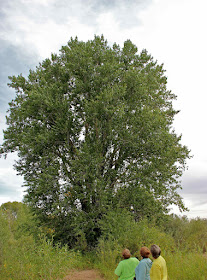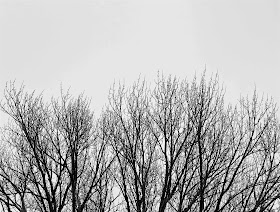 |
Stopping for dinner at the Antelope Truck Stop, near Burns, Wyoming.
|
See the Wind?
(inspired by Christina Rossetti)
Who has seen the wind?
Neither I nor you:
But if tumbleweeds stop traffic,
The wind is passing through.
Who has seen the wind?
Neither you nor I:
But when a train flies overhead,
The wind is passing by.
For several days, my house has threatened to take off for Nebraska. We huddle inside, loathe to go out and be pelted by sand and flying garbage. So this is a good time to share the assorted information, stories and photos I’ve collected over the years.
If southeast Wyoming is going have severe weather, it’s only fitting that it be wind. Our high-altitude prairies and broad ridges let the prevailing westerlies strut their stuff, especially in winter. Average speeds of 30-35 mph are fairly common. But 50 mph with gusts to 70 is altogether something else, qualifying as a storm. So it was on Monday—making the front page of the Laramie Boomerang, ahead of the State Senate budget debate. Two days later, we were warned it would happen again, this time lasting 36 hours.
These winds break trees, knock down fences, and close highways even when there’s no snow. They howl and shake the house, scaring the dogs. They unsettle me too, especially when they wake me in the middle of the night! I decided to make the best of it and educate myself. For example: Why does the wind blow?
Wind is ”bulk movement of air”—specifically from areas of high pressure to low (source). And that’s exactly what happened. Air moving toward a pressure low in western South Dakota rushed across southeast Wyoming (quotes in caps are from NOAA Forecast Discussion; italics are mine).
[yesterday morning] A WIDESPREAD AND POTENTIALLY SIGNIFICANT HIGH WIND EPISODE IS LIKELY ACROSS SOUTHEAST WYOMING AND THE WESTERN NEBRASKA PANHANDLE OVER THE NEXT 24 TO 36 HOURS. … THIS IS THE RESULT OF STRENGTHENING PRESSURE FALLS ACROSS WESTERN SDThis was going to be an exceptional pressure gradient:
WE CANNOT RULE OUT A FEW HIGH WIND GUSTS THIS AM BEFORE LOW-LEVEL MIXING REALLY CRANKS UP … THIS IS BY FAR THE HIGHEST PROBABILITY OF ANY CASE WE STUDIED IN THE LAST 15 YEARS….SO THIS SHOULD BE A BIG EVENT.I braced the broken fence post, wished the dogs good luck, and left to commiserate with friends over coffee.
But a true storm didn’t materialize. Average wind speed never got above 38 mph, with gusts to just 49—mere spring breezes!
• • •
Still, there was plenty of howling and wailing, as winds will do. Remember that great song about the wind called Maria (muh-RYE-uh)? It’s the song of a lonely cowboy out on the plains, longing for his sweetheart far away. Maria first appeared in the novel Storm by George Rippey Stewart (1941). As he explained, “The soft Spanish pronunciation is fine for some heroines, but our Maria here is too big for any man to embrace and much too boisterous. … So put the accent on the second syllable, and pronounce it ‘rye’.” (source)
Away out here they got a name
For rain and wind and fire
The rain is Tess, the fire's Joe
And they call the wind Maria
Maria blows the stars around
And sends the clouds a-flyin'
Maria makes the mountains sound
Like folks up there was dyin’.
But Stewart, cowboys, myself and everyone else who has described the sound of the wind are wrong. Wind is silent. What we hear are things it disturbs, rubs against, sets in motion, breaks: leaves and limbs shaking against each other; wooden fences being abraded and broken; sand hitting the windshield; standing waves in power lines. The howling might be due to vortices that arise downstream from objects (source).
Yeah okay … maybe technically the wind is silent. But I’m not about to say that “the vortex downstream from my house was really howling.” It was the wind!
• • •
Of course wind is not all bad. Plants, gods and humans use it to their advantage.
Dandelions, cottonwoods, willows and many more plants cast their seeds to the wind. Tumbleweeds travel with the wind, dropping seeds as they roll along.
 |
Sending the kids out into the world (source).
|
 |
“Please release me!”—to broadcast more seeds.
|
Fūjin, the Japanese wind god, carries the winds in a large bag. When the world was created, he let them out to clear the mist.
 |
Wind god Fūjin is considered a terrifying wizard-like demon (source). Maybe it’s Fūjin’s howling we hear when the wind blows.
|
Humans farm wind, including here in southern Wyoming. We would have even more wind farms if there were large urban areas nearby. Our high winds produce lots of energy, for energy is proportional to the square of wind velocity. And when wind passes a rotor oriented vertically to its path, energy becomes proportional to the third power of velocity! (source).
According to the State Climate Office, Wyoming ranks first in the nation in terms of windiness. We could supply approximately 66 million homes with energy annually, if only we could get it there (i.e. approximately 42,875 sq mi of available windy land, with potential yield of 747 billion kWh per year with wind energy potential (average power) of 85,200 MW).
 |
Wind power generated in Wyoming by month (2011; source). Note high levels this time of year.
|
To me, wind farms look like sparse forests of perfectly-spaced giant weird trees—reminiscent of baobabs.
 |
Source (of base photo).
|
Moving turbines are mesmerizing—it's easy to be distracted driving through a farm.
Wind farms are nothing new. Residents of the High Plains have been harvesting wind for years—even without Federal subsidies.
 |
This old windmill still pulls up water.
|
• • •
There are various ways to measure wind. Wind direction refers to where it's coming from. Direction is most often measured with a pivoting weather vane. Wind speed is measured with anemometers, e.g. propellers or rotating cups. But in a pinch, a wind sock can show direction, and give a rough approximation of speed by the angle at which it’s hanging. Here’s the famous Wyoming windsock, of which we’re so proud:


















































